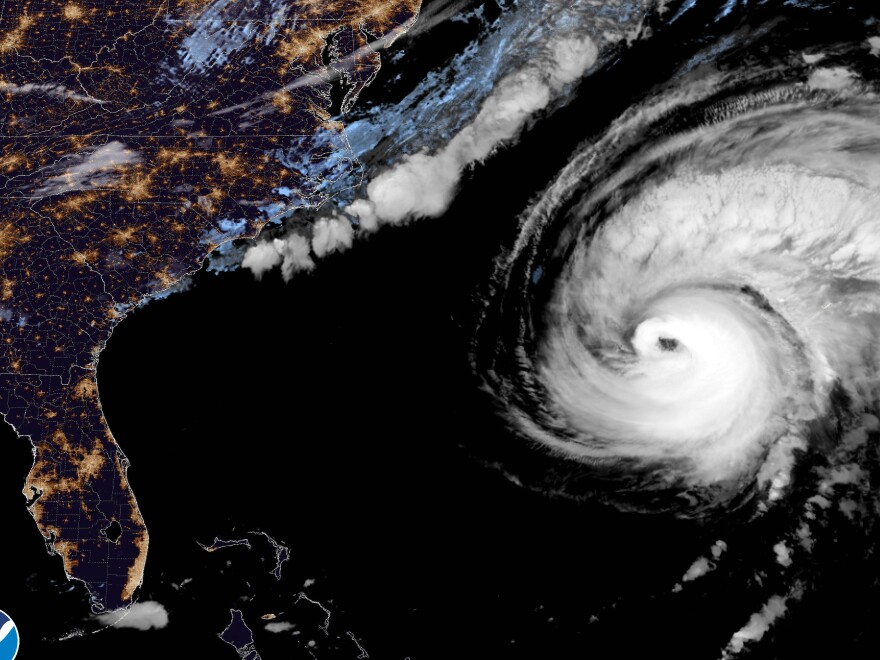Updated September 23, 2022 at 11:19 AM ET
CAGUAS, Puerto Rico — Fiona, a Category 3 hurricane, pounded Bermuda with heavy rains and winds early Friday as it swept by the island on a route forecast to have it approaching northeastern Canada late in the day as a still-powerful storm.
Authorities in Bermuda opened shelters and closed schools and offices ahead of Fiona. Premier David Burt sent a tweet urging residents to "take care of yourself and your family. Let's all remember to check on as well as look out for your seniors, family and neighbors."
The Canadian Hurricane Centre issued a hurricane watch over extensive coastal expanses of Nova Scotia, Prince Edward Island and Newfoundland. The U.S. National Hurricane Center said Fiona should reach the area as a "large and powerful post-tropical cyclone with hurricane-force winds."
"It certainly has the potential to be one of the most severe systems to have hit eastern Canada," said Ian Hubbard, meteorologist for the Canadian Hurricane Centre in Dartmouth, Nova Scotia.
Hubbard said the center of the storm is expected to arrive Saturday morning sometime between 9 a.m. and 10 a.m. locally, but winds and rains will arrive late Friday.
Authorities in Nova Scotia sent an emergency alert to phones warning of Fiona's arrival and urging people to say inside, avoid coastlines, charge devices and have enough supplies for at least 72 hours.
The U.S. center said Fiona had maximum sustained winds of 125 mph (205 kph) late Thursday. It was centered about 125 miles (200 kilometers) north of Bermuda, heading north-northeast at 25 mph (41 kph).
Hurricane-force winds extended outward up to 115 miles (185 kilometers) from the center and tropical storm-force winds extended outward up to 275 miles (445 kilometers).
A hurricane warning was in effect for Nova Scotia from Hubbards to Brule; Prince Edward Island; Isle-de-la-Madeleine; and Newfoundland from Parson's Pond to Francois.
Fiona so far has been blamed for at least five deaths — two in Puerto Rico, two in the Dominican Republic and one in the French island of Guadeloupe.
Hurricanes in Canada are somewhat rare, in part because once the storms reach colder waters, they lose their main source of energy and become extratropical. But those cyclones still can have hurricane-strength winds, though with a cold instead of a warm core and no visible eye. Their shape can be different, too. They lose their symmetric form and can more resemble a comma.
Bob Robichaud, Warning Preparedness Meteorologist at the Canadian Hurricane Centre, said at a news conference that modelling projected "all-time" low pressure across the region, which would bring storm surges and rainfall of between 10 to 20 centimeters (4 to 8 inches).
Amanda McDougall, mayor of Cape Breton Regional Municipality, said officials were preparing a shelter for people to enter before the storm arrived.
"We have been through these types of events before, but my fear is, not to this extent," she said. "The impacts are going to be large, real and immediate."
Dave Pickles, chief operating officer of Nova Scotia Power, said it expected widespread power outages.
Meanwhile, the National Hurricane Center said that a tropical depression in the southern Caribbean is expected to hit Cuba early Tuesday as a hurricane and then hit south Florida early Wednesday.
It was located about 615 miles (985 kilometers) east-southeast of Kingston, Jamaica. It had maximum sustained winds of 35 mph (55 kph) and was moving at 13 mph (20 kph).
Before reaching Bermuda, Fiona caused severe flooding and devastation in Puerto Rico, leading U.S. President Joe Biden to say Thursday that the full force of the federal government is ready to help the U.S. territory recover.
Speaking at a briefing with Federal Emergency Management Agency officials in New York, Biden said, "We're all in this together."
Biden noted that hundreds of FEMA and other federal officials are already on the ground in Puerto Rico, where Fiona caused an island-wide blackout.
More than 60% of power customers remained without energy Thursday and a third of customers were without water, while local officials said they could not say when service would be fully restored.
As of Friday, hundreds of people in Puerto Rico remained isolated by blocked roads five days after the hurricane ripped into the island. Frustration was mounting for people like Nancy Galarza, who tried to signal for help from work crews she spotted in the distance.
"Everyone goes over there," she said pointing toward crews at the bottom of the mountain who were helping others also cut off by the storm. "No one comes here to see us. I am worried for all the elderly people in this community."
At least five landslides covered the narrow road to her community in the steep mountains around the northern town of Caguas. The only way to reach the settlement was to climb over thick mounds of mud, rock and debris left by Fiona, whose floodwaters shook the foundations of nearby homes with earthquake-like force.
At least eight of the 11 communities in Caguas were completely isolated, said Luis González, municipal inspector of recovery and reconstruction.
It was one of at least six municipalities where crews had yet to reach some areas. People there often depend on help from neighbors, as they did following Hurricane Maria, a Category 4 storm in 2017 that killed nearly 3,000 people.
Danciel Rivera arrived in rural Caguas with a church group and tried to bring a little cheer by dressing as a clown.
"That's very important in these moments," he said, noting that people had never fully recovered from Hurricane Maria.
His huge clown shoes squelched through the mud as he greeted people, whose faces lit up as they smiled at him.
Copyright 2022 NPR. To see more, visit https://www.npr.org.





